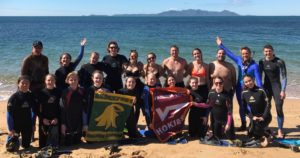
Students from Virginia Tech and The College at Brockport (State University of New York) work with Reef Ecologic and Bungalow Bay on a citizen science Great Barrier Reef restoration project.
Students from Virginia Tech and The College at Brockport, SUNY, write: The Great Barrier Reef is like a sick trauma patient. It is suffering from mass coral bleaching, excessive seaweed or macroalgae, poor water quality, runoff, and other ailments. In many places, it is degraded and dying; however, it is not dead yet. So what are people doing to breathe new life into this patient? University students from Virginia Tech and The College at Brockport (State University of New York), in collaboration with Reef Ecologic and Bungalow Bay, experienced firsthand how to restore the Great Barrier Reef and learn why coral reef restoration is important. The Great Barrier Reef is a living, diverse ecosystem that provides many significant services to humans, similar to other ecosystems across the globe. It is important to learn about these ecosystems, so that we can conserve them.
The following video details some of our efforts and experiences in our AUIP Hokies Abroad course, during which we worked with Reef Ecologic on a citizen science project focused on coral reef restoration: https://youtu.be/99mXcEZEYfw
The Great Barrier Reef is the largest coral reef ecosystem on the planet. It is a living organism that provides a home for a diversity of plant and animal species. The Great Barrier Reef is a network of coral reefs located off of Australia’s east coast. Coral is an animal that has a symbiotic relationship with an algae called zooxanthellae. These tiny organisms live in coral structures and harvest sunlight, much like plants on land, to create energy for themselves and the coral. Coral and zooxanthellae work together to keep the reef healthy.
So what does the Great Barrier Reef do for us? The reef protects the beautiful beaches of Australia by breaking waves and slowing them. The reef can also absorb excess carbon in the atmosphere, providing oxygen for the colorful life that inhabits it. There are roughly 6,000 species of marine life that call this reef their home. It is the unique and diverse aquatic community that draws many people to Australia, contributing significantly to Australia’s economy. According to Nathan Cook, a scientist from Reef Ecologic, the Great Barrier Reef’s net worth is estimated at 900 billion dollars.
What is happening now? Currently, there are several threats to the reef, which include climate change and nutrient runoff. Our project focused on removing excess macroalgae from the reef associated with runoff from coastal development. These macroalgae outcompete coral for space. By removing small sections of macroalgae, we provided the coral with more room to colonize and grow. Even though we only removed a relatively small amount of macroalgae, the continuation of reef restoration projects like this can give the Great Barrier Reef a second chance at life.

Students from Virginia Tech and The College at Brockport counting macroalgae removed from the Great Barrier Reef at Nelly Bay.
Our experience with the Hokies Abroad Australia and New Zealand program gave us the opportunity to give back to our environment in a way we never thought possible. In the spirit of Ut Prosim, we participated in a citizen science project to help restore a degraded part of the Great Barrier Reef. Though not everyone can visit the Great Barrier Reef, there are still ways that you can help. To learn more about Great Barrier Reef conservation efforts and ways to get involved, visit Reef Ecologic and Great Barrier Reef Marine Park Authority.
By Rebecca Brassfield, Tyvanté Gillison, Norah Hopkins, Irene Jenkins, Jillian Kazmierczak and Alex Mansueto






